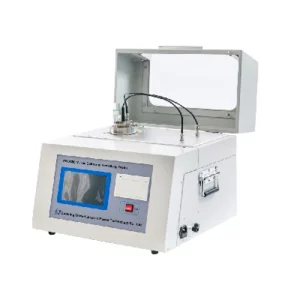Oil testers use various methods to detect contaminants in oil samples, depending on the type of contaminants and the sensitivity required. Some common methods include:
- Particle Counting: Oil testers equipped with particle counting sensors detect and quantify solid contaminants, such as wear debris, dirt, and metallic particles, suspended in the oil. This method typically involves passing the oil sample through a sensor that counts and sizes particles based on their optical or electrical properties.
- Filtration: Filtration techniques involve passing the oil sample through a filter medium with a specific pore size that captures contaminants above a certain size threshold. After filtration, the captured contaminants can be visually inspected or analyzed using microscopy or other techniques.
- Spectroscopy: Spectroscopic methods, such as atomic absorption spectroscopy (AAS), inductively coupled plasma (ICP) spectroscopy, or optical emission spectroscopy (OES), detect and quantify trace elements and metals present in the oil. These techniques analyze the elemental composition of the oil sample and identify contaminants based on their characteristic emission or absorption spectra.
- Titration: Titration methods measure the acidity or alkalinity of the oil sample, which can indicate the presence of acidic or basic contaminants, such as organic acids or alkalis. oil tester Acid number (AN) and base number (BN) tests are commonly used to assess the degree of contamination by acidic or basic compounds.
- Viscosity Measurement: Changes in oil viscosity can indicate contamination by substances that alter the fluid’s flow properties, such as water, fuel, or other fluids. Oil testers equipped with viscometers or viscosity sensors can detect deviations from the expected viscosity values and identify potential contaminants.
- Dielectric Analysis: Dielectric analysis measures the electrical properties of the oil sample, such as dielectric constant or dissipation factor, to detect the presence of polar contaminants, water, or other conductive substances. Changes in dielectric properties can indicate contamination or degradation of the oil.
- Gas Analysis: Gas chromatography (GC) or gas detection sensors can be used to analyze the dissolved gas content in the oil sample. Abnormal levels of gases, such as oxygen, nitrogen, carbon dioxide, or hydrocarbons, may indicate contamination by air, fuel, or other volatile substances.
- Water Content Measurement: Oil testers equipped with moisture sensors or Karl Fischer titration systems can quantify the water content in the oil sample. Elevated water levels can indicate contamination by water or emulsified fluids, which can lead to lubrication problems and accelerated wear.
These methods can be used individually or in combination to comprehensively analyze oil samples and detect various types of contaminants, helping maintain equipment reliability, prevent component wear, and optimize lubricant performance.

What methods does an oil tester use to detect contaminants in oil samples?